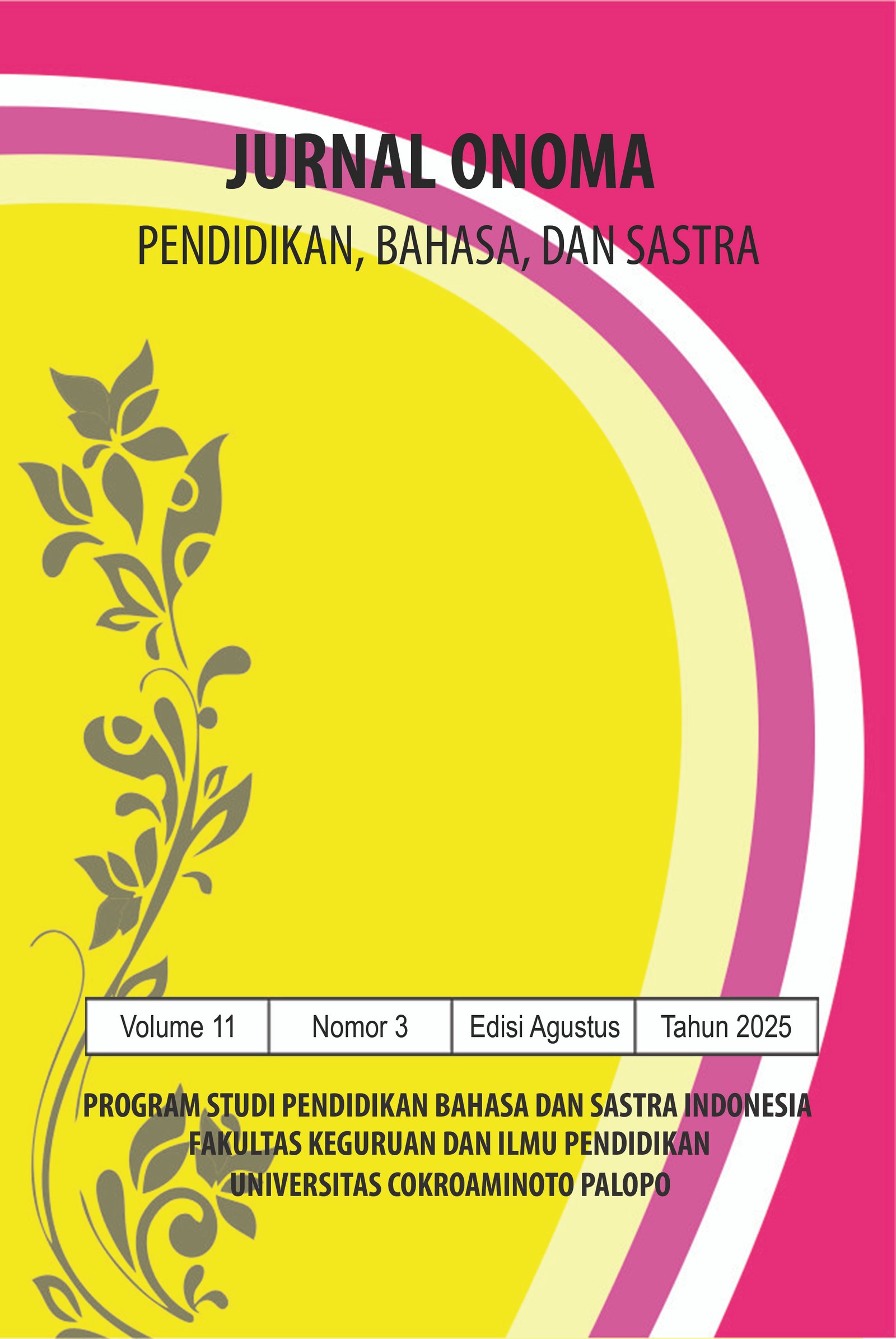Dinamika Konflik Batin dan Pergeseran Nilai Budaya dalam Cerpen Pulang Karya OJ Hara
https://doi.org/10.30605/onoma.v11i3.5728
Keywords:
Pulang, pendekatan struktural, konflik batin, nilai budayaAbstract
Penelitian ini bertujuan menganalisis konflik batin tokoh utama dalam cerpen Pulang karya OJ Hara. Penelitian ini menggunakan pendekatan kualitatif dengan jenis deskriptif kualitatif. Data dikumpulkan dengan teknik studi pustaka dan pencatatan kutipan yang relevan. Data dianalisis menggunakan teori strukturalisme. Hasil penelitian menunjukkan bahwa tema sentral dalam cerpen ini adalah dilema antara ambisi pribadi dan tanggung jawab sosial yang tercermin dalam pergulatan batin tokoh Tri Siswanto saat menghadapi permintaan ayahnya untuk pulang ke desa. Latar tempat dan sosial memperkuat ketegangan tersebut, dengan kontras antara kehidupan sederhana di desa dan kemewahan di kota besar. Sudut pandang orang ketiga serba tahu memungkinkan narasi menggali kedalaman psikologis tokoh secara efektif. Penelitian ini menyimpulkan bahwa cerpen Pulang merefleksikan dinamika pergeseran nilai budaya antara modernitas dan tradisi serta menegaskan pentingnya tanggung jawab keluarga dalam menentukan identitas diri. Temuan ini memberikan kontribusi dalam pemahaman sastra Indonesia kontemporer khususnya dalam analisis struktural dan tema konflik budaya.
Downloads
References
Barthes, R. (1977). Image, music, text. The Journal of Aesthetics and Art Criticism, 37, 220.
Chairul, S. F., Suparno, D., Iroth, S., & Ratu, D. M. (2021). Konflik Internal Tokoh Utama dalam “Mimpi Kecil Tita” Karya Desi Puspitasari. Dialektika: Jurnal Bahasa, Sastra, Dan Pendidikan Bahasa Dan Sastra Indonesia, 8(1), 85–106. https://doi.org/10.15408/dialektika.v8i1.6188
Culler, J. (2000). Literary theory: A very short introduction. Oxford University Press.
Damono, S. D. (2019). Sosiologi Sastra: Pengantar Ringkas. Gramedia Pustaka Utama.
Fauziyah, F., & Nurhaliza, P. (2024). Representasi Konflik Sosial dalam Cerpen Dilema Nara Karya Alya Khalisah kita . Munculnya konflik dalam masyarakat tidak mungkin bisa dihindari karena keberagaman ( Rahmawati & Sulanjari , 2022 ). Konflik sosial dapat dipicu oleh. 2(2), 26–38. https://doi.org/10.51817/lrj.v2i2.892
Genette, G. (1980). Narrative Discourse: An Essay in Method. Cornell University Press.
Levi-Strauss, C. (1963). Structural anthropology. Basic Book.
Marentino, F., & Nugraha, D. (2025). Konflik Batin Tokoh Utama dalam Novel Bumi Manusia Serta Relevansinya terhadap Pembelajaran Sastra di SMA. Jurnal Onoma: Pendidikan, Bahasa, Dan Sastra, 11(1), 331–341.
Nurlaela, N. (2019). Konflik Antargenerasi dalam Karya Sastra Modern Indonesia. Gajah Mada University Press.
Pobela, J. A., & Bagtayan, Z. A. (2024). Analisis Konflik Batin pada Tokoh Utama dalam Crita Rakyat Loloda’ Mokoagow Kajian Psikologi Sastra. Jurnal Kajian Ilmiah Interdisiplinier, 8(12), 253–263.
Propp, V. (1968). Morphology of the folktale (2nd ed.). University of Texas Press.
Saputra, R. (2021). Perubahan Nilai Tradisional dalam Cerpen Indonesia Kontemporer: Sebuah Pendekatan Psikologis. Angkasa.
Syawalia, L., Ecca, S., Mahmud, N., & Kamal. (2024). Dinamika Naratif Film “Hati Suhita” Karya Khilma Anis. Nuances of Indonesian Languages, 5(2), 127–138. https://doi.org/10.51817/nila.v5i2.965
Teeuw, A. (2003). Sastra dan Ilmu Sastra: Pengantar Teori Sastra. Pustaka Jaya.
Todorov, T. (1969). Grammaire du Décaméron. Moutun.
Downloads
Published
How to Cite
License
In submitting the manuscript to the journal, the authors certify that:
- They are authorized by their co-authors to enter into these arrangements.
- The work described has not been formally published before, except in the form of an abstract or as part of a published lecture, review, thesis, or overlay journal.
- That it is not under consideration for publication elsewhere,
- That its publication has been approved by all the author(s) and by the responsible authorities – tacitly or explicitly – of the institutes where the work has been carried out.
- They secure the right to reproduce any material that has already been published or copyrighted elsewhere.
- They agree to the following license and copyright agreement.
License and Copyright Agreement
Authors who publish with Onoma Journal: Education, Languages??, and Literature agree to the following terms:
- Authors retain copyright and grant the journal right of first publication with the work simultaneously licensed under Creative Commons Attribution License (CC BY 4.0) that allows others to share the work with an acknowledgment of the work's authorship and initial publication in this journal.
- Authors are able to enter into separate, additional contractual arrangements for the non-exclusive distribution of the journal's published version of the work (e.g., post it to an institutional repository or publish it in a book), with an acknowledgment of its initial publication in this journal.
- Authors are permitted and encouraged to post their work online (e.g., in institutional repositories or on their website) prior to and during the submission process, as it can lead to productive exchanges, as well as earlier and greater citation of published work.

















